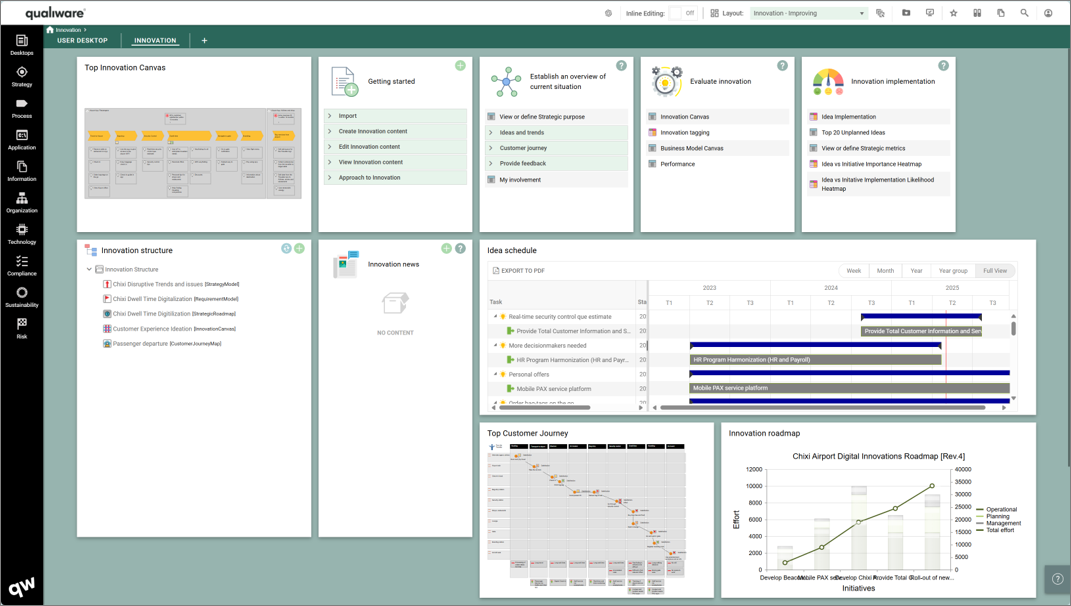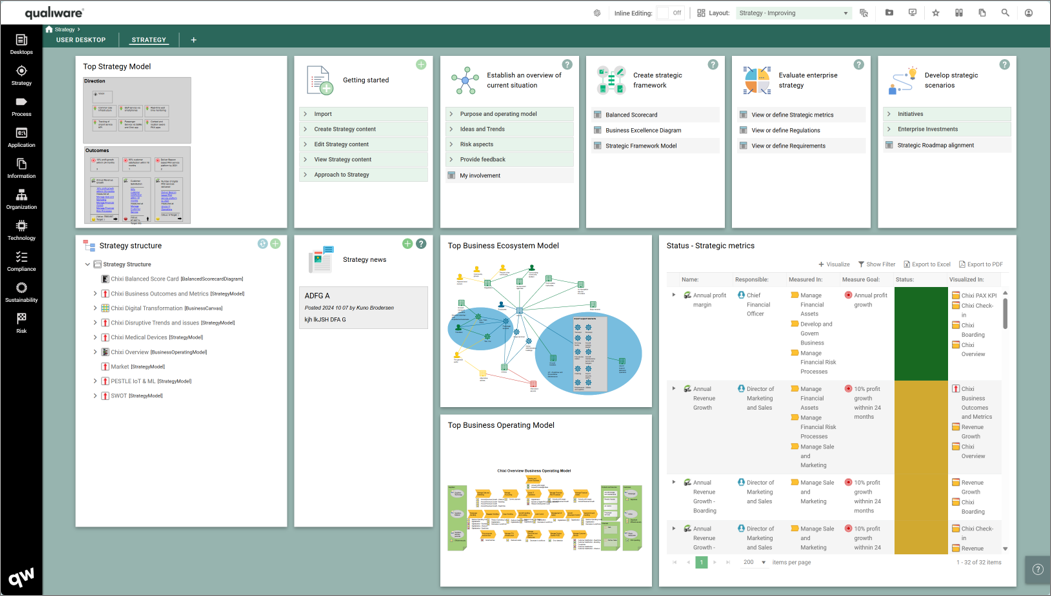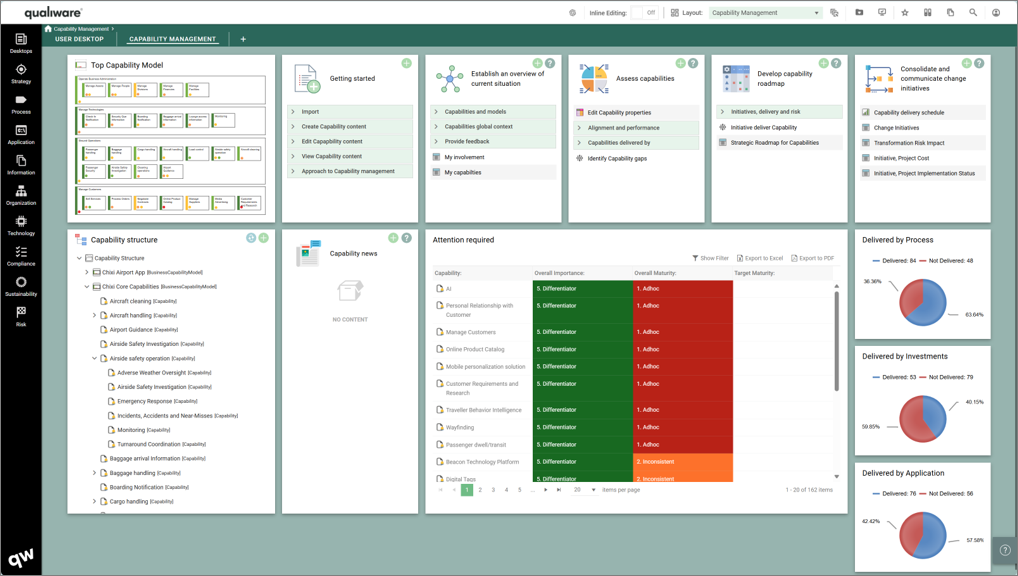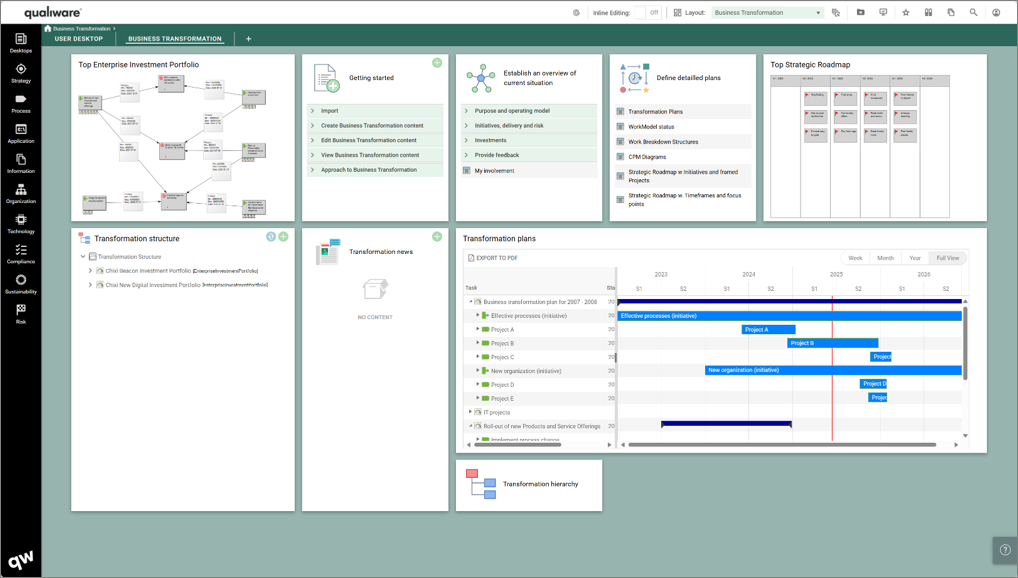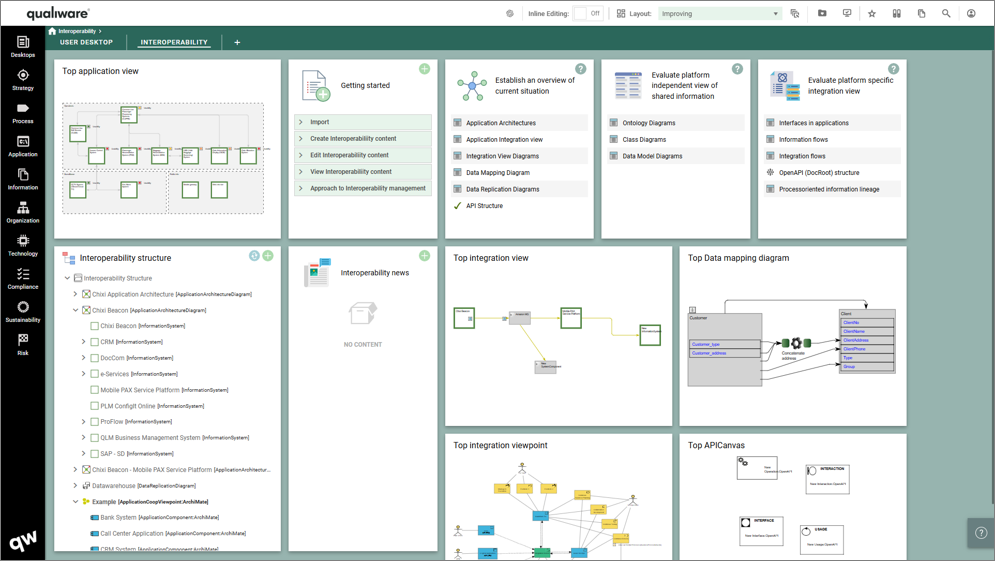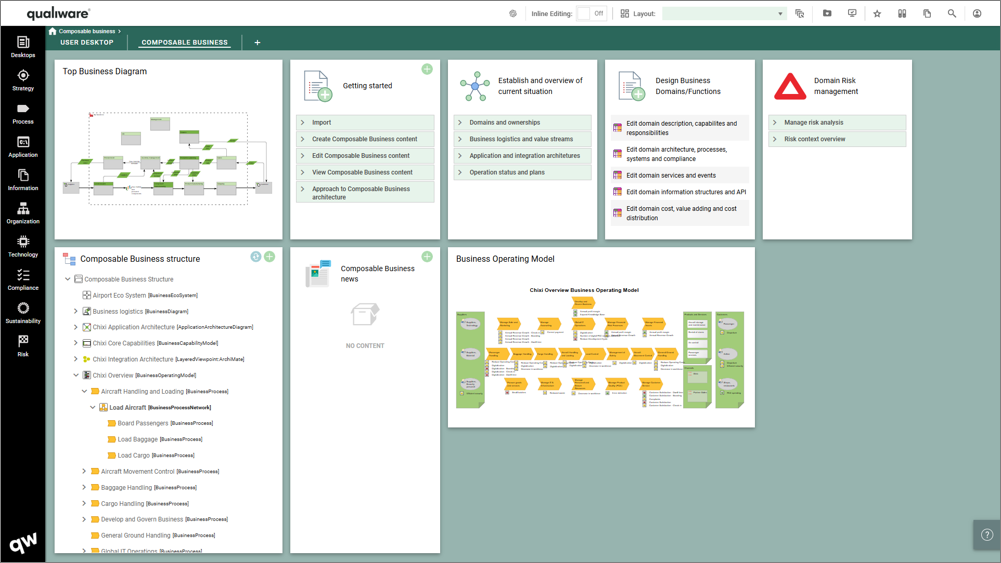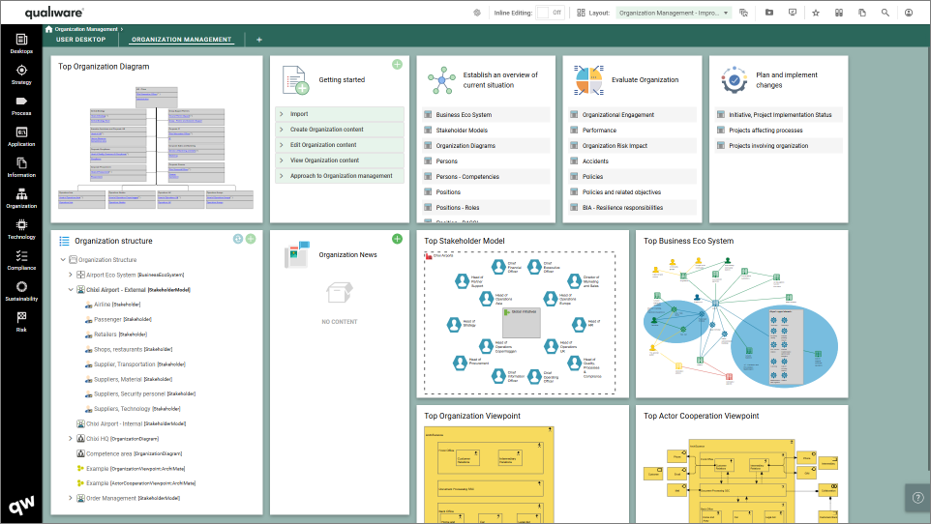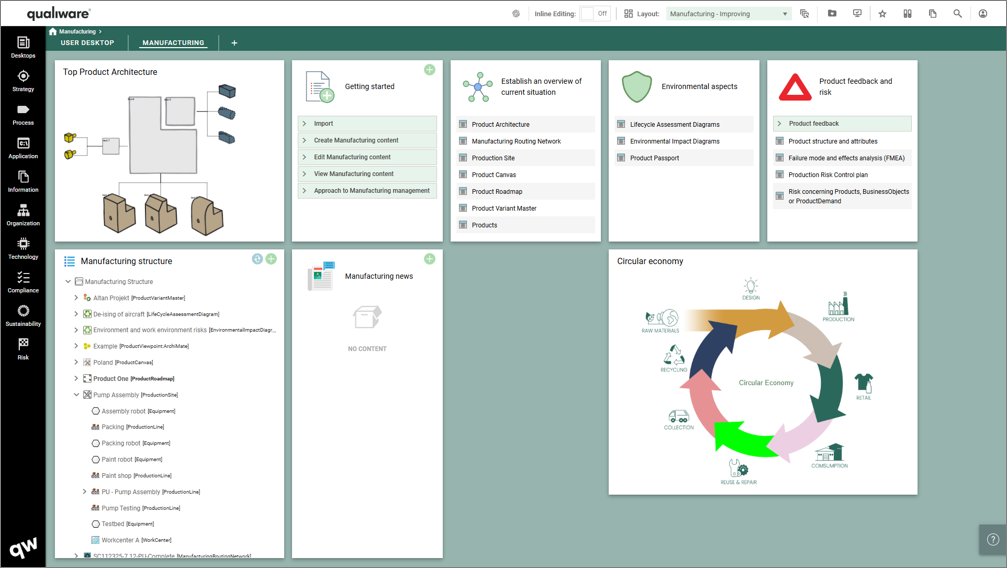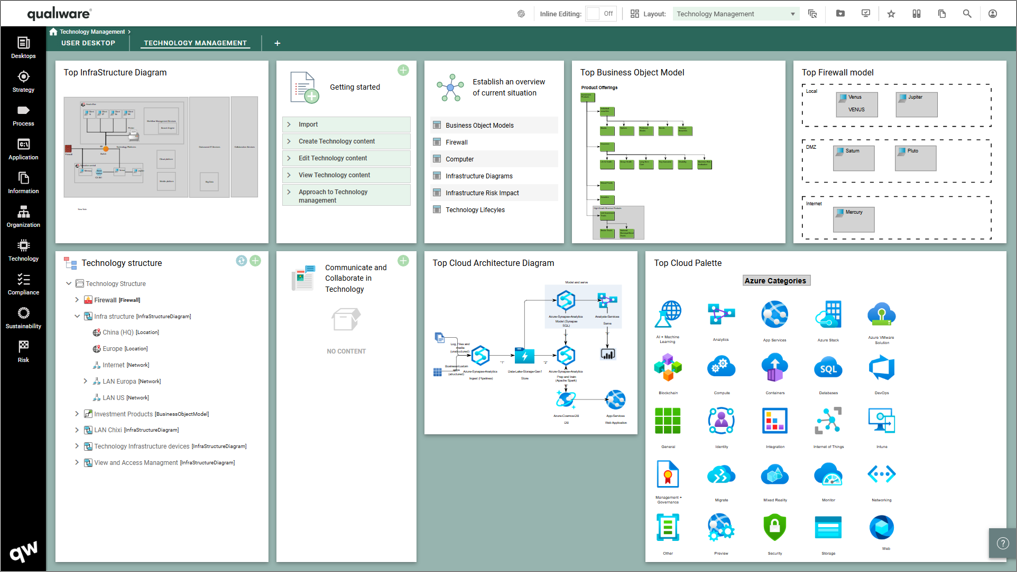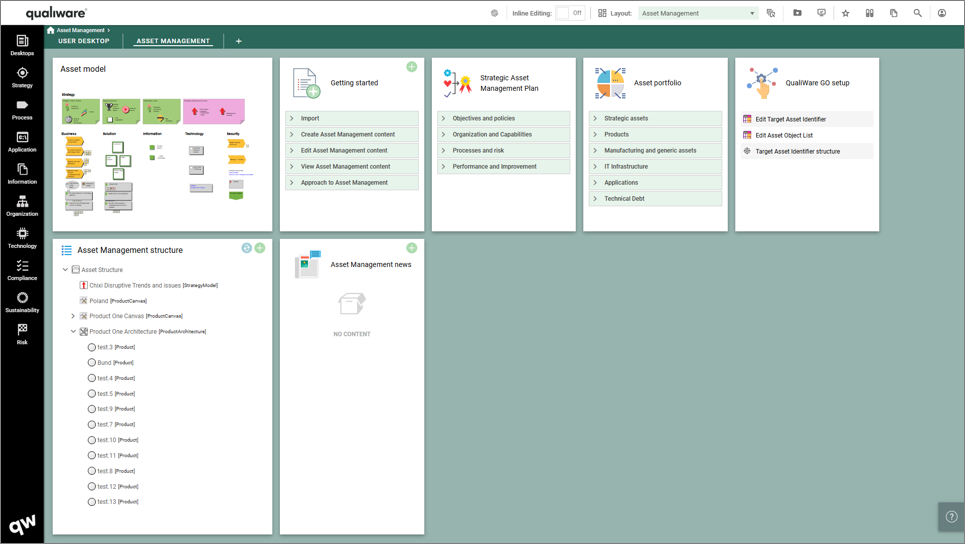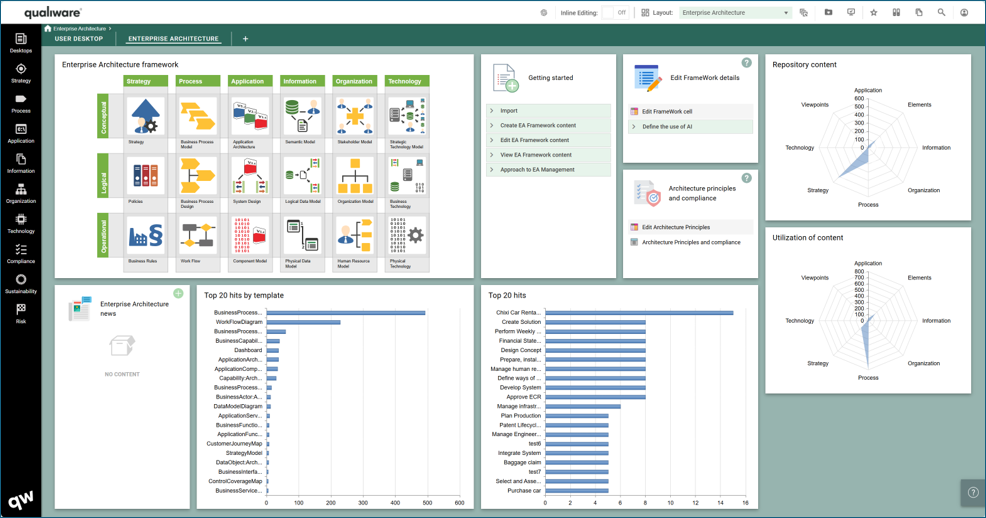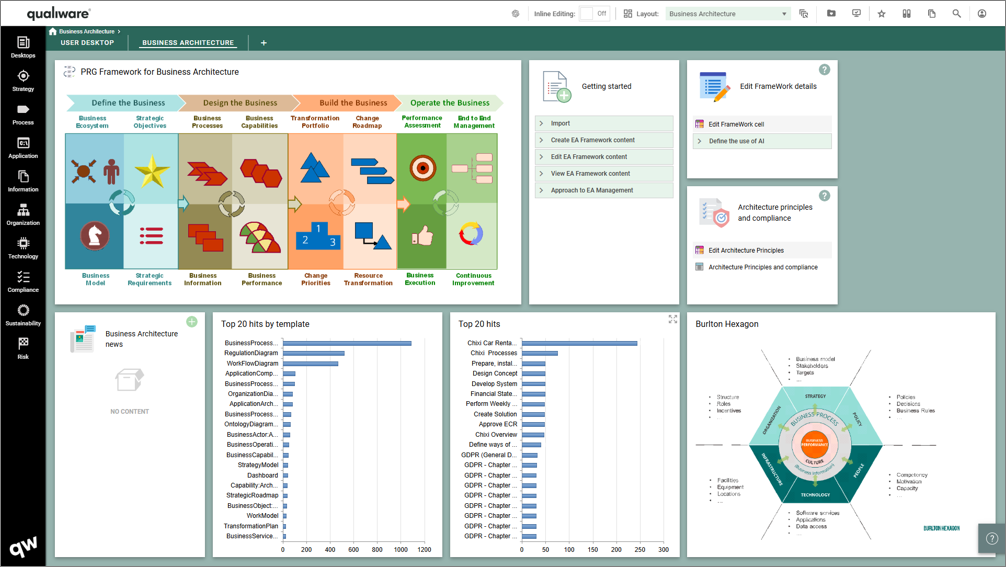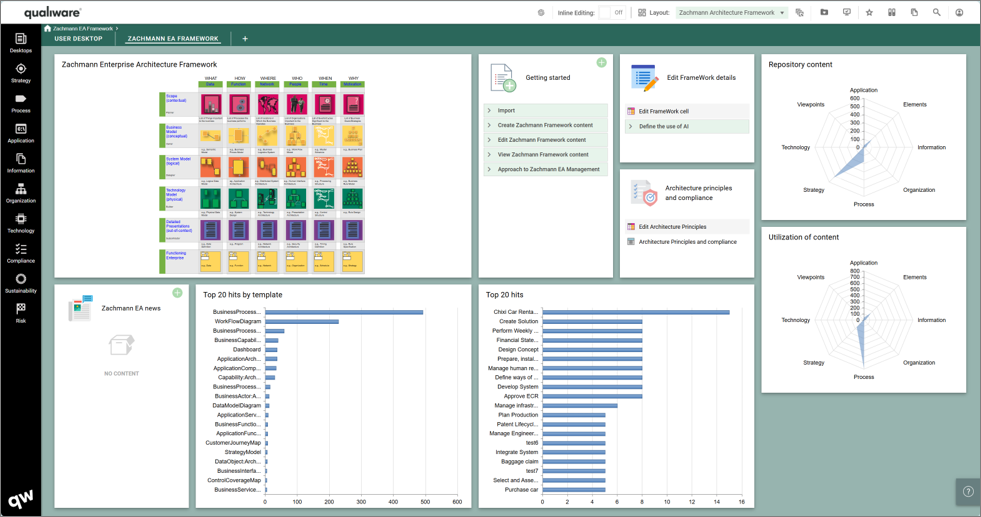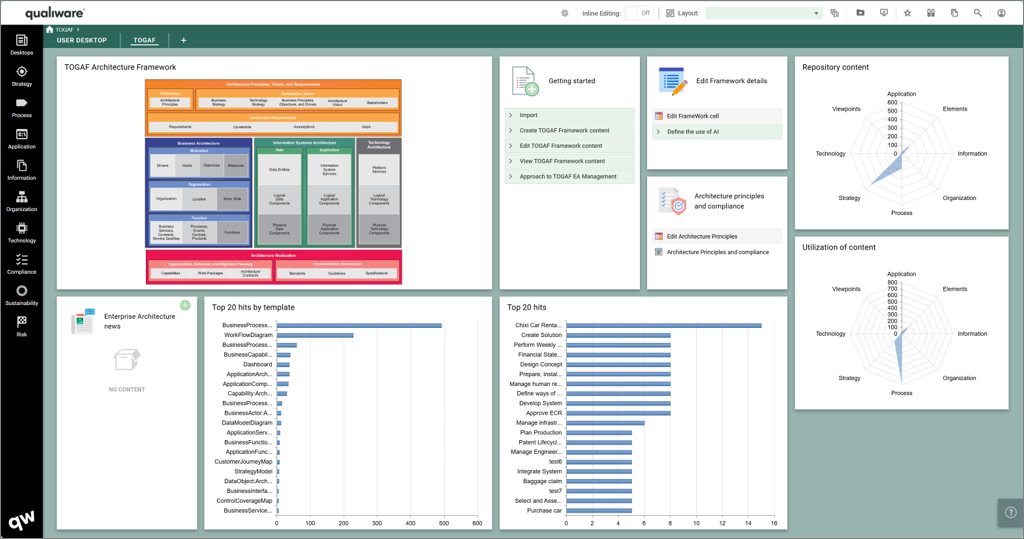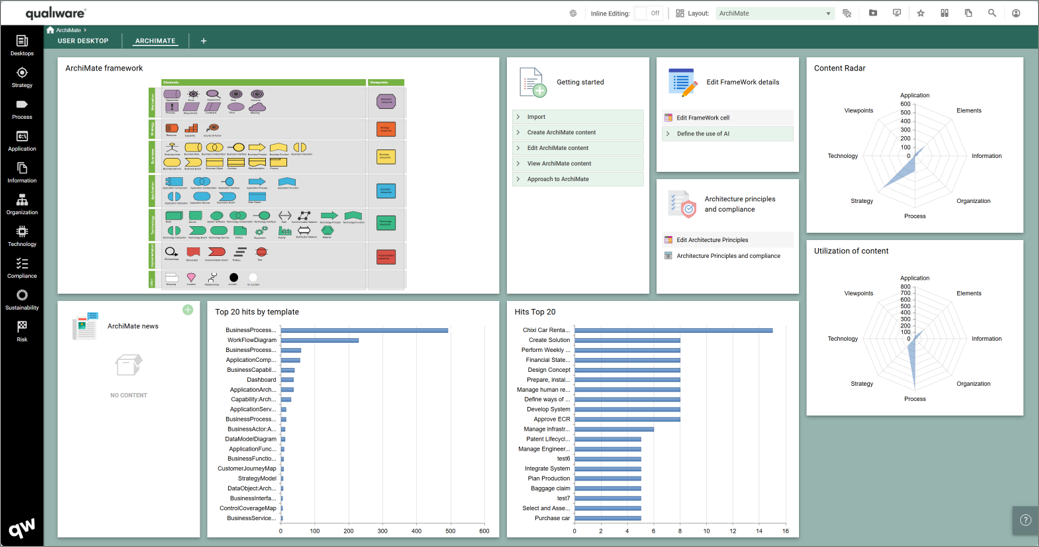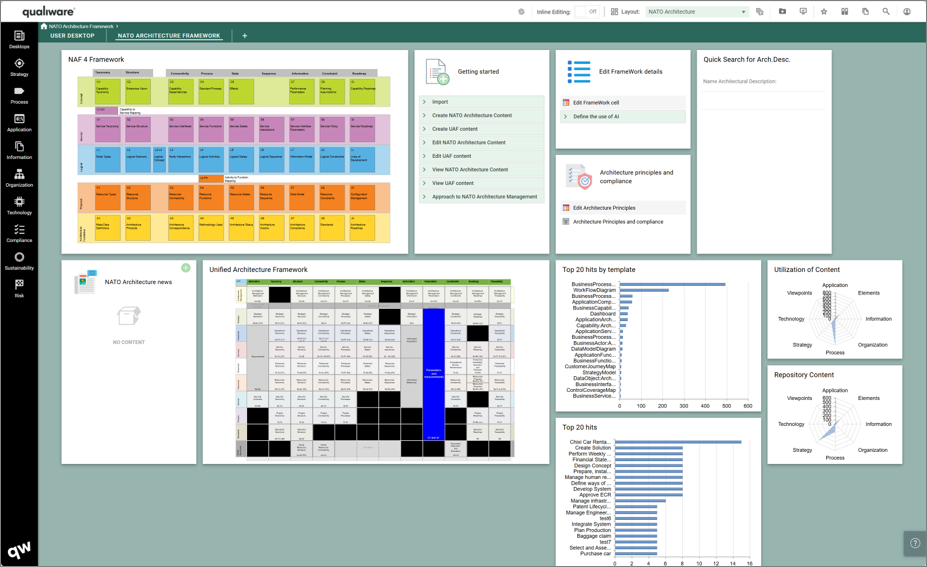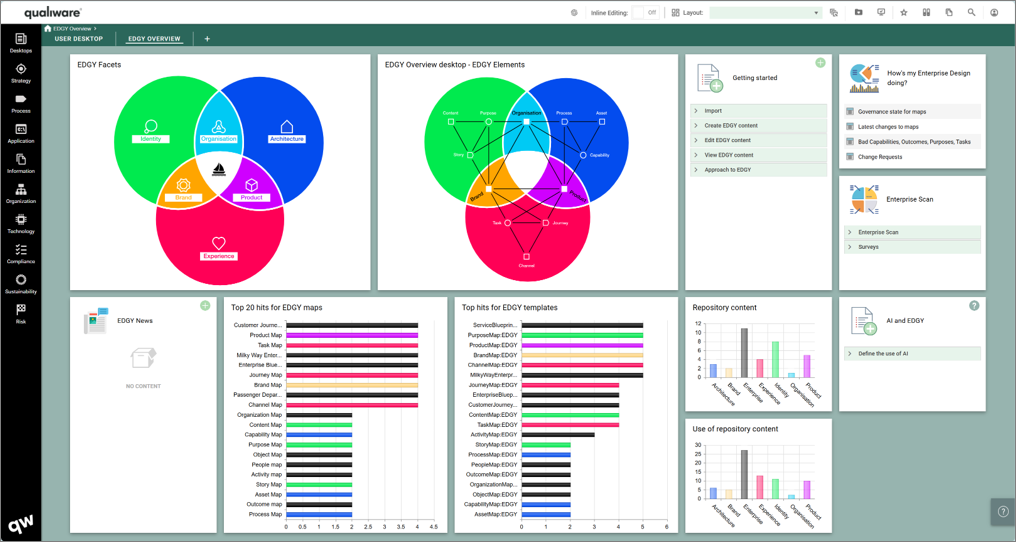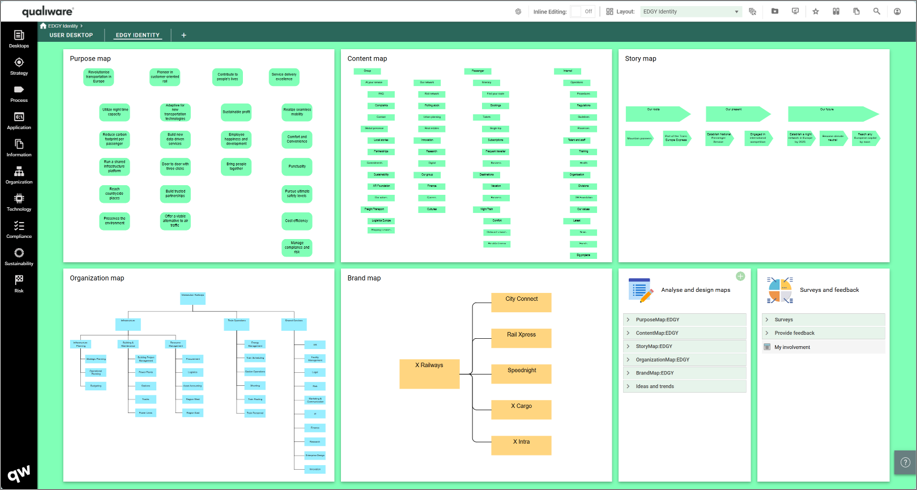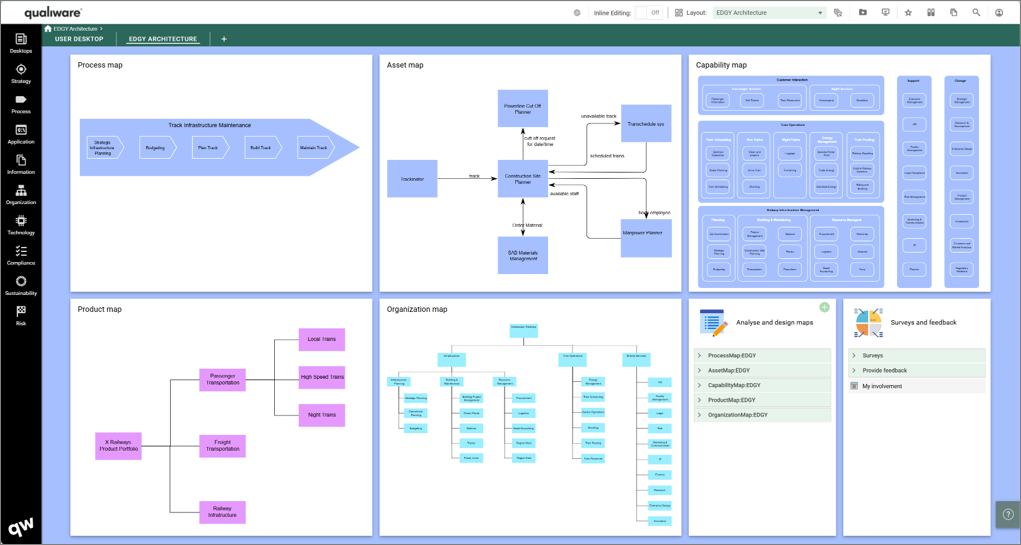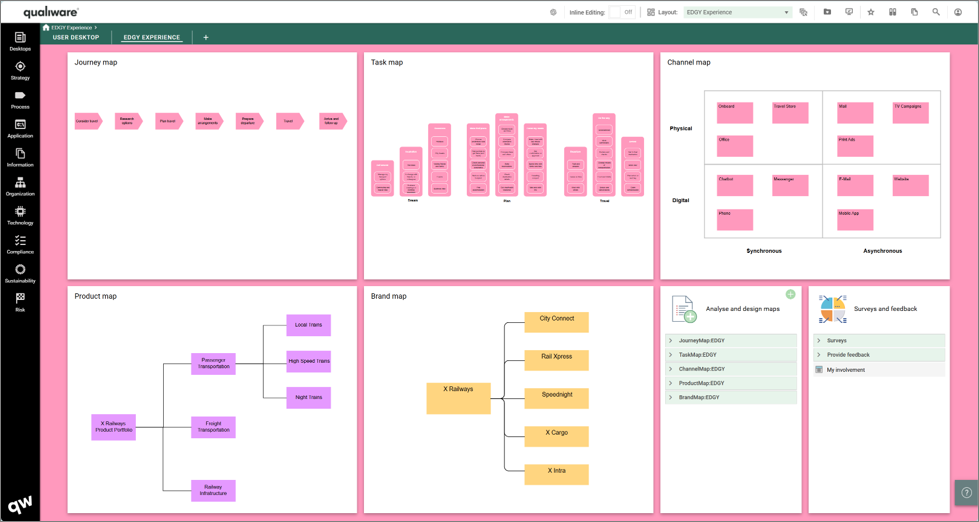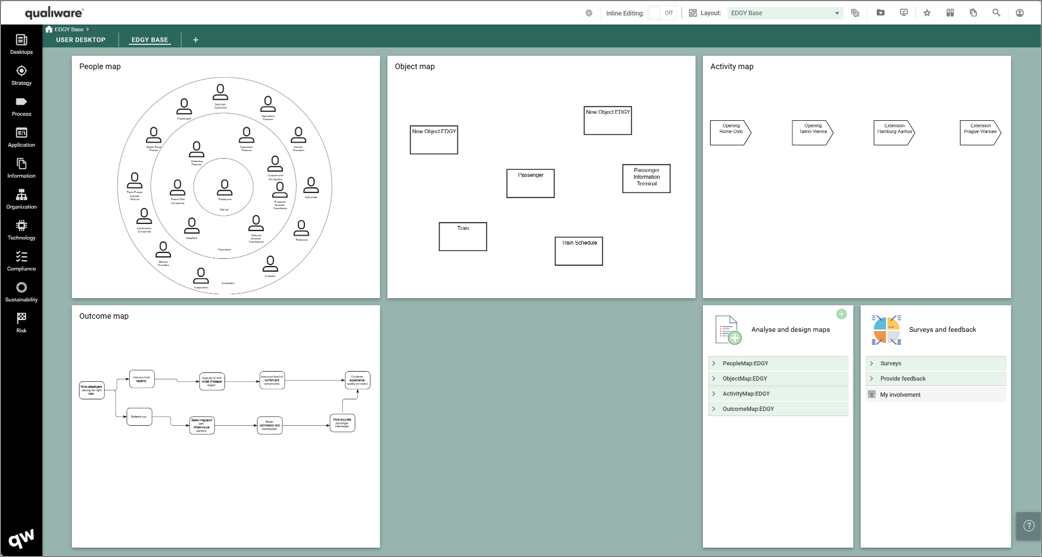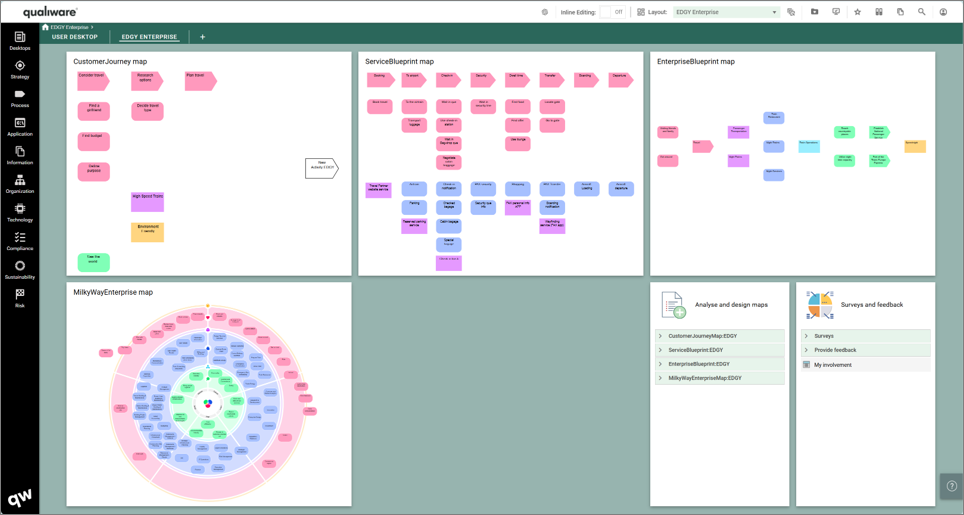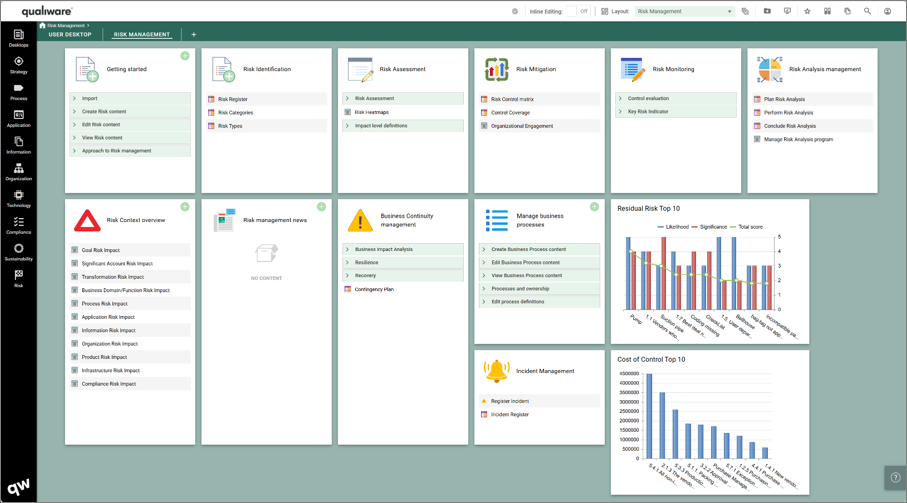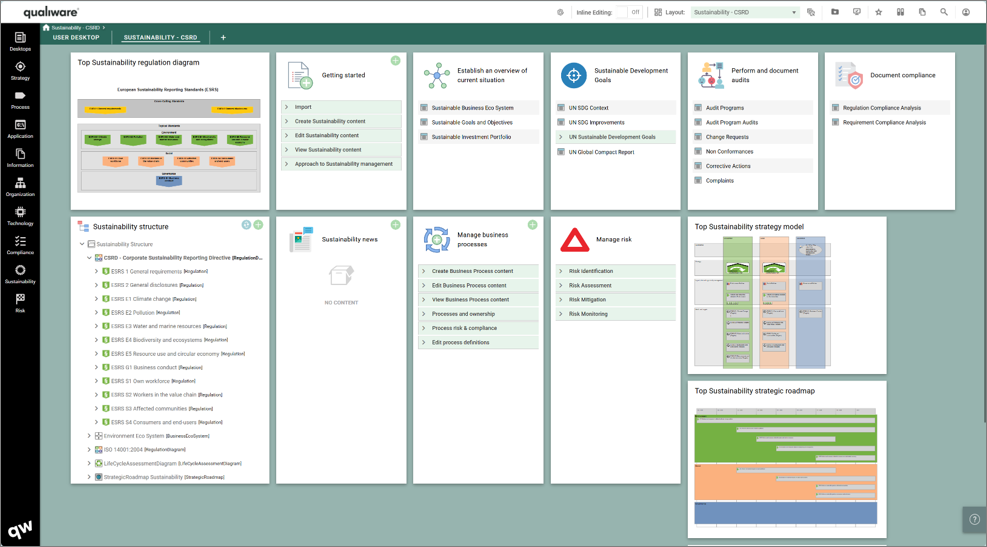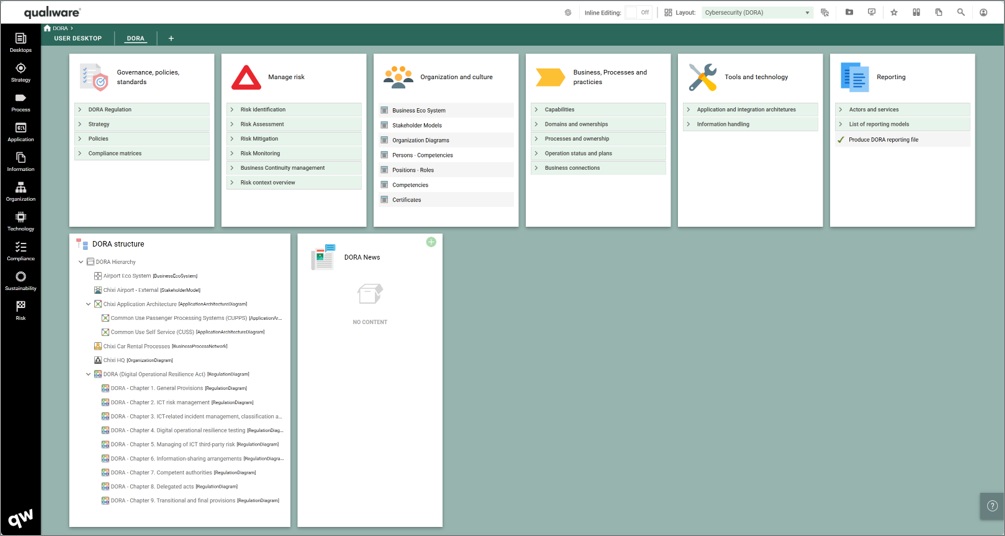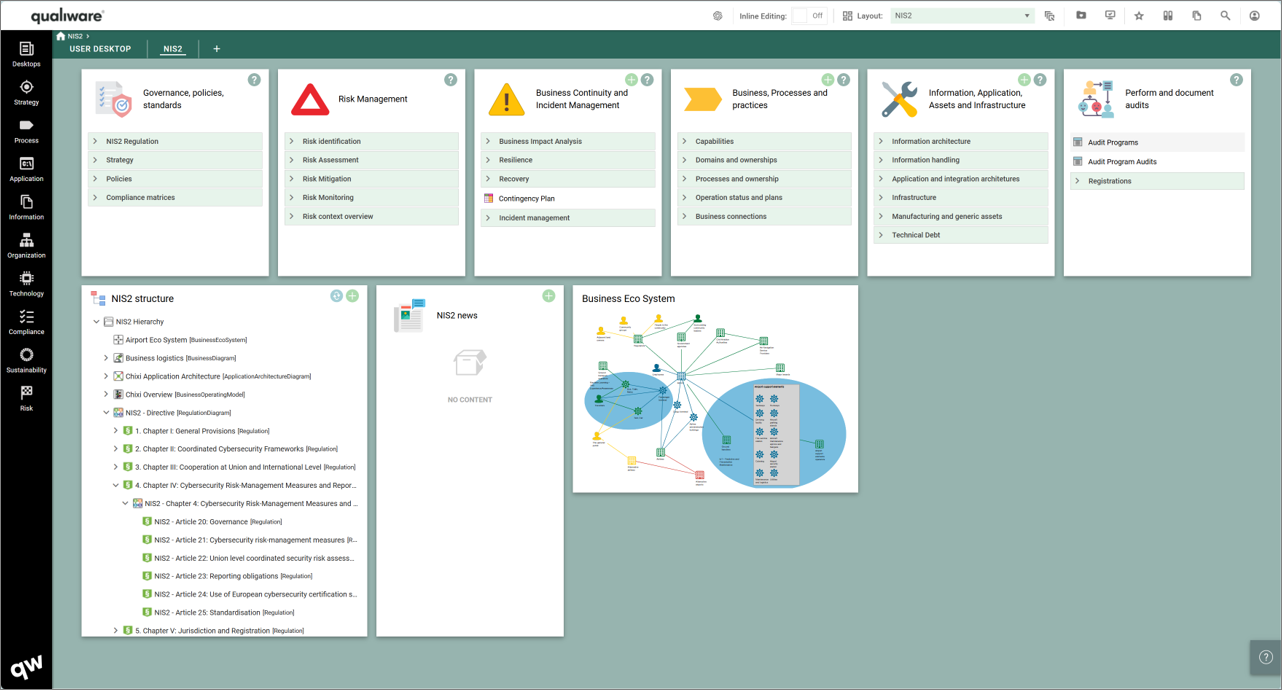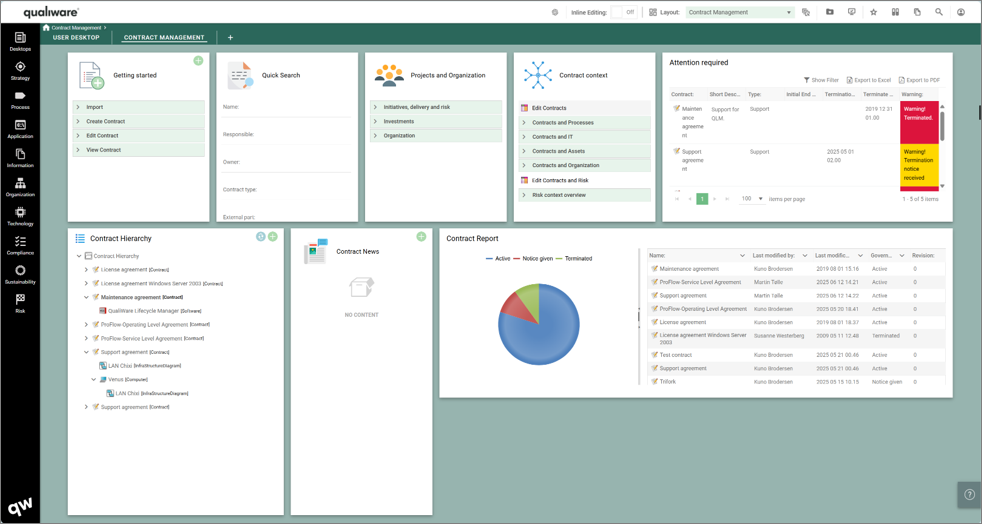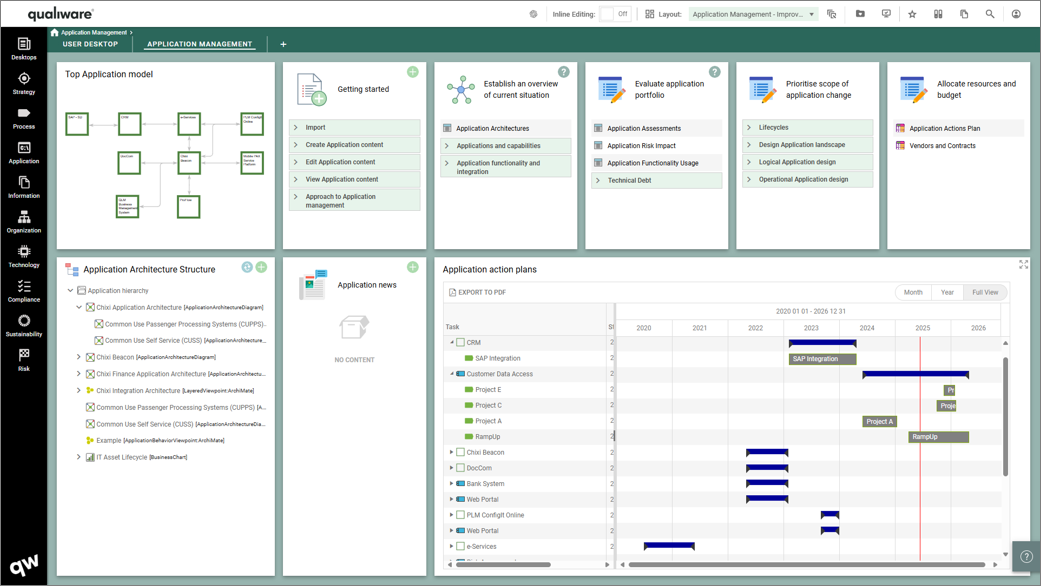
- Summary
- Desktop Types
- Layout
- Task / Journey based
- Hierarchy view
- Relevant Desktop News
- Choose among available Desktop (Add/Remove Desktop Tabs)
- End-user Customizable
- Personal Desktop
- My Personal Actions
- Easy to Add/Pin content to personal Desktop
- Additional Features
- Standard Desktops
- Configuring Desktops
Summary
QualiWare 10.10 introduces a whole set of purpose-based Desktops focusing on a dedicated subset of e.g. an architectural aspect or specific task:
- each desktop support the whole journey within a specific domain from:
- getting started
- exploring the current situation
- analyse/improve the content
- follow up
All the desktops are based upon the dashboard feature introduced in QualiWare 10.8 for diagrams; this means that:
- it is possible to set up multiple layouts for a desktop, e.g. browsing view for the content user; and an analyzing and improving view for the content owner
- the desktop can be customized by the user
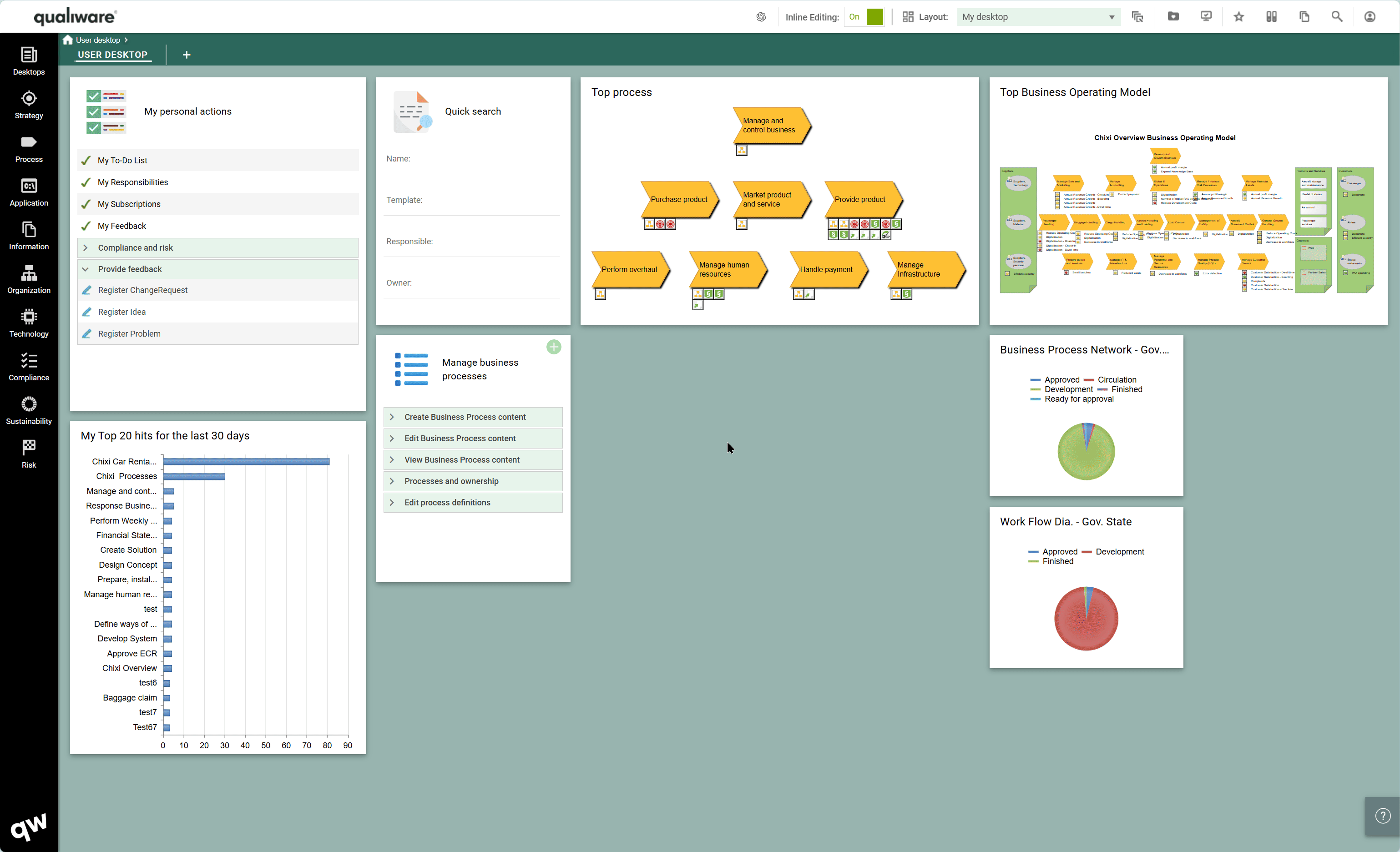
Different types of Desktops
QualiWare is a very comprehensive tools that enables you to model and manage every part of your business and using the modelling framework of your choice, and/or documenting and fulfilling compliance requirement of one or more regulations or standards.
The new set of desktops captures all relevant parts for your task at hand in each of the dedicated desktops, being it capability, application or process management, or documenting compliance for an ISO-standard or CSRD, NIS2, DORA, GDPR or other regulations.
The tool contains a comprehensive set of standard desktops, each focusing on a architectural aspect, architectural framework or one or more areas within governance, risk or compliance.
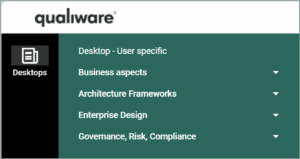
From the left menu, you have access to all available desktops. The desktops are grouped according to their purpose:
- Business Aspects:
- Desktops focusing on the full journey within an architectural or business domain, e.g. capability, application, process or manufacturing
- Architectural Frameworks:
- Desktops focusing on an Architectural Framework, and how it is applied and used within the organization
- Enterprise Design
- A set of Desktops tailored to the EDGY Framework and its different facets
- Governance, Risk and Compliance
- Comprehensive risk and compliance Desktops as well as a set of Desktops each dedicated to a specific regulation or ISO standard

Explore the list of standard desktops here.
Desktop Layout
All desktops are structured around the same high level layout, allowing the users to get a fast and easy access to the content and features they are looking for.
Architecture Aspects Desktops
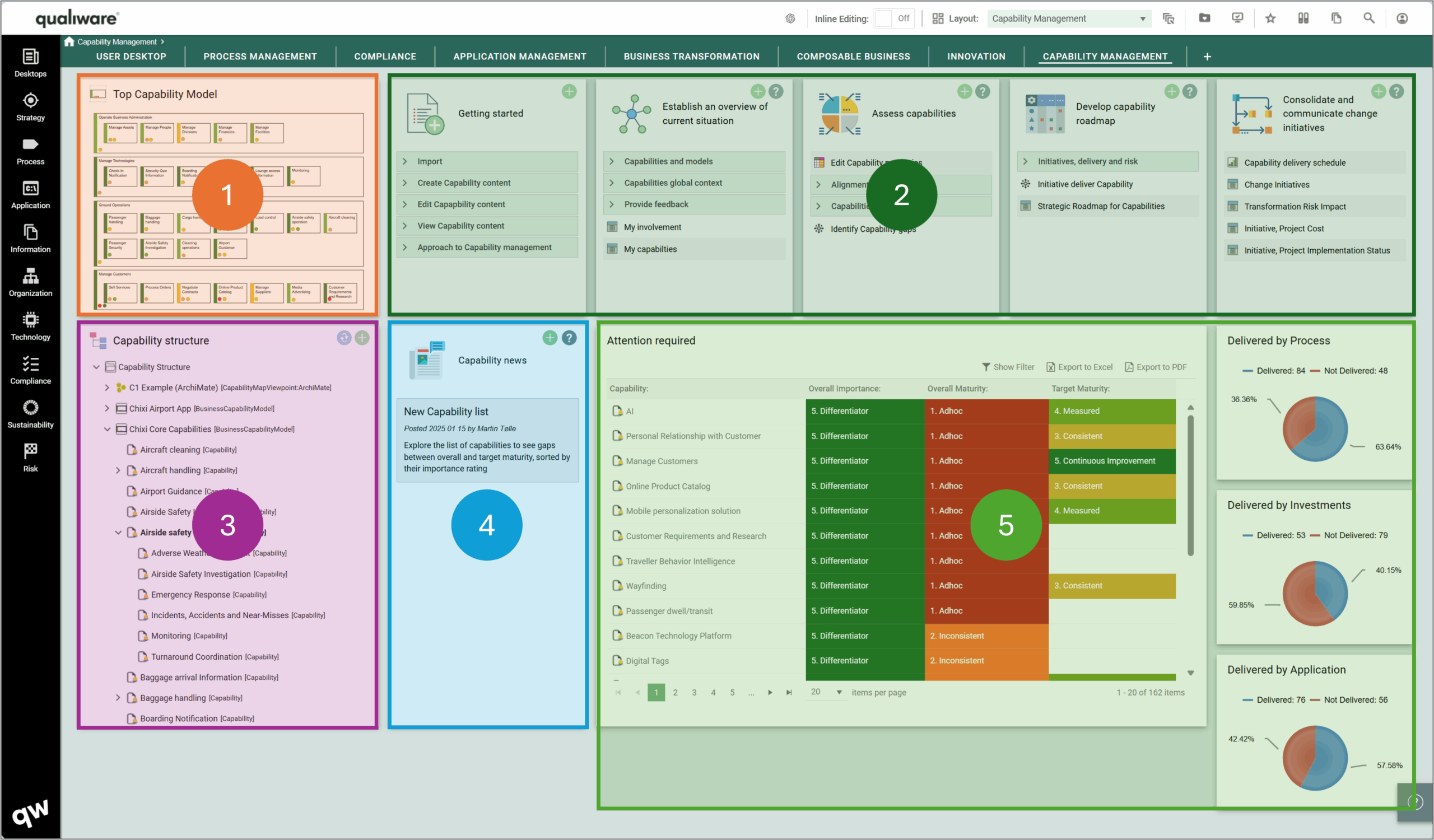
- Top Diagram for the content in the desktop
- Purpose based tiles, that covers the whole journey within the purpose of the Desktop, see more below
- Hierarchy view, collection of most relevant content with in the desktop focus
- News section, a “local” desktop news feed, where users can collaborate and share relevant news
- Metrics and additional diagrams, showing KPIs, charts, and additional content
Purpose based desktops
The concept of a desktop is to capture and focus areas and support the user throughout the journey of the development and maturing of that particular area from “getting started” to browsing, modifying, and monitoring of the status.

Getting Started
Each Desktop has a “Getting Started” tile that provides easy access to the most relevant features in relation to the focus on the desktop.
The tile is organised in a unified way throughout the desktops.
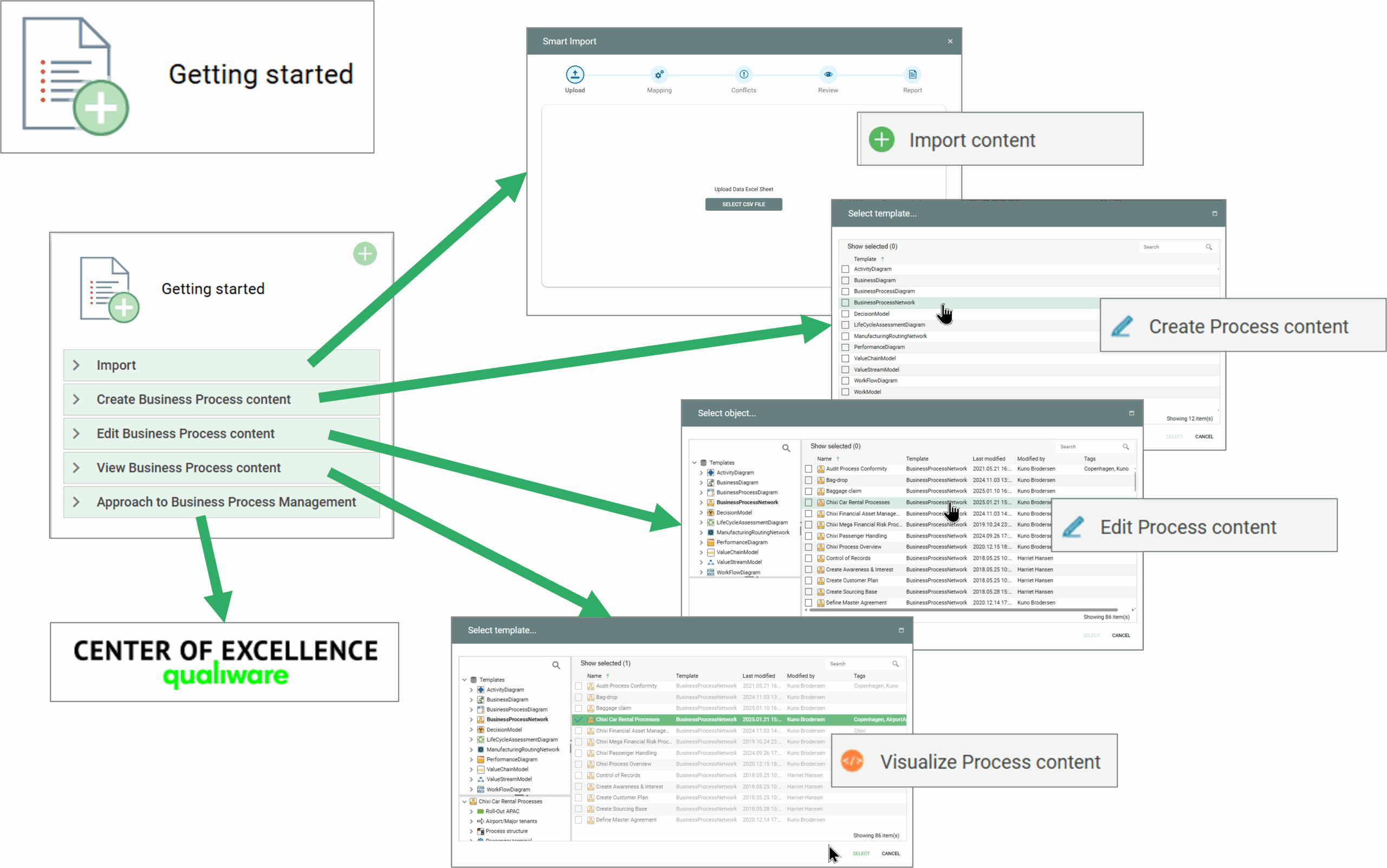
“Getting Started” tile contains:
- Easy access to the smart importer enabling you to import existing content from other sources via e.g. CSV-files (read more about the Smart Importer here)
- Create content, displays a list of relevant model types within the focus area of the desktop, allowing you to create new models within the scope of the desktop
- Edit content, displays a searchable list of existing models within the focus area of the desktop, allowing you to edit existing models within the scope of the desktop
- Visualize content, displays a searchable list of existing models within the focus area of the desktop, allowing you to visualize existing models within the scope of the desktop
- Approach to …, contains a set of references to methodological content on QualiWare Center of Excellence and/or other sources (where relevant)
Task based tiles for different steps in the journey
In addition to the getting started a set of additional tiles are available on the desktops, aiming to represent sub-tasks within the purpose of the desktop.
Each tiles have a heading e.g. “Establish an overview of current situation” and contains one or more groups of queries and lists.
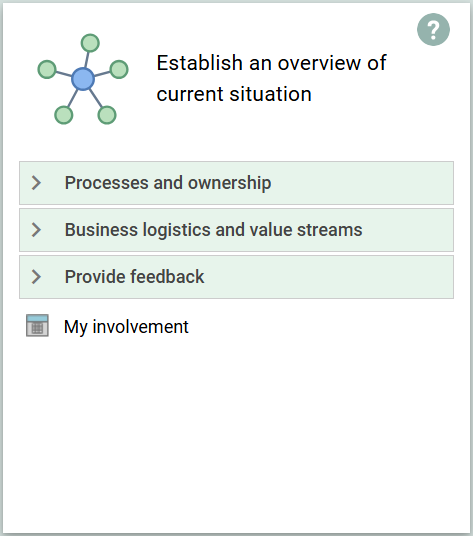
The “Current Situation” tile gives access to queries and list of the essential objects types related to the desktop.
In addition, there is easy access to a list with all the objects that are related to the user under the “My Involvement”.
The tiles can contain 2 levels, grouping the detailed queries and list under a higher level of type, below example from the process desktop.
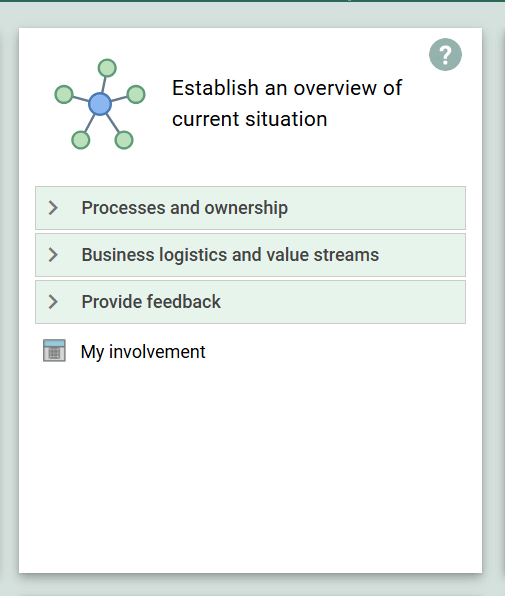
Hierarchy/Structure view
Many of the desktops includes a Hierarchy / Structure view where it is possible to collect most relevant diagrams and content related to the Desktop.
The hierarchy view is browsable, the user can unfold the hierarchy to explore the structure and navigate directly to a specific diagram.
This feature has been part of QualiWare for some time, and is known from the Diagram-Dashboards for e.g. Processes and Applications (see more here).
What is new, however, is that you easily can add/modify the models that should be part of the structure view. The structure updates automatically, and hierarchy are updated as part of the governance flow when new diagrams are added via the “breakdown to” or “visualized by” relations.
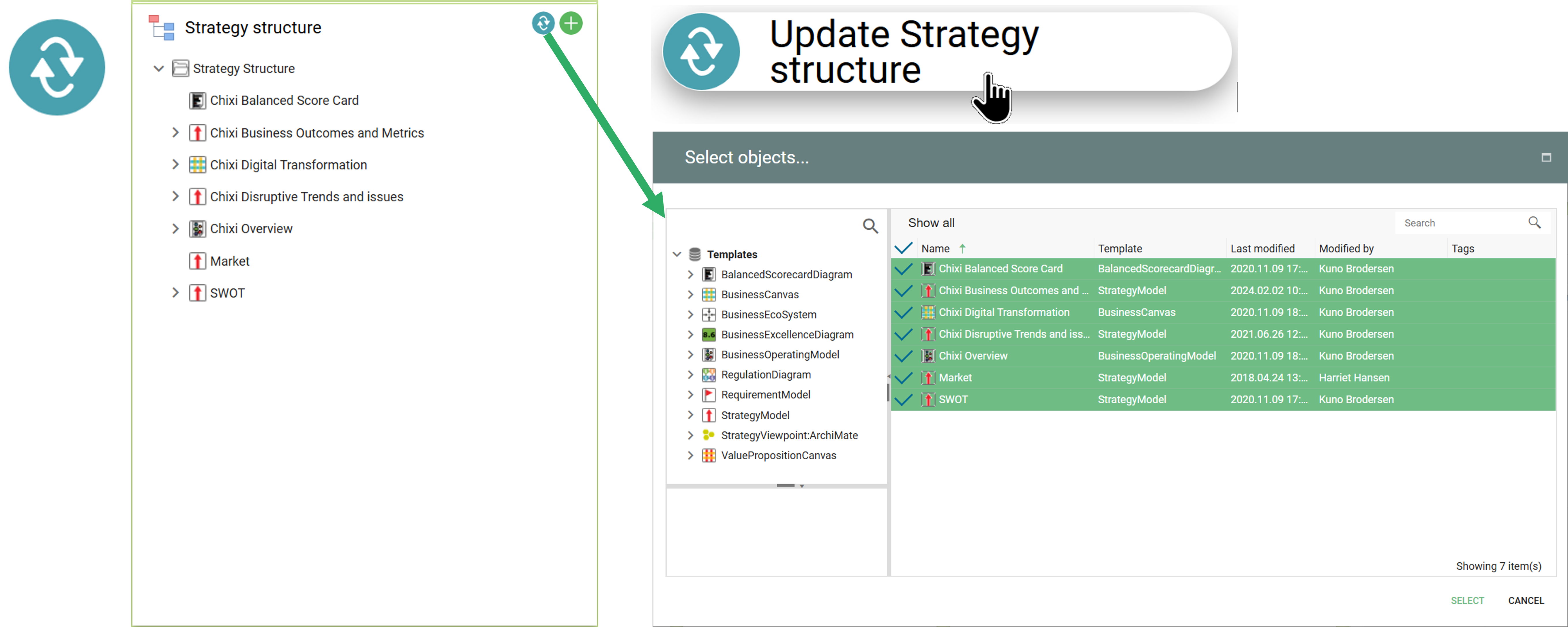
News
There is a news tile on the desktops where relevant “local” desktop news easily can be created and shared on the platform to relevant insights and enhance the collaboration about the content.
The news are shown on the desktop, and applies the standard generic NewsItem template that have been available in the toolset for many years.
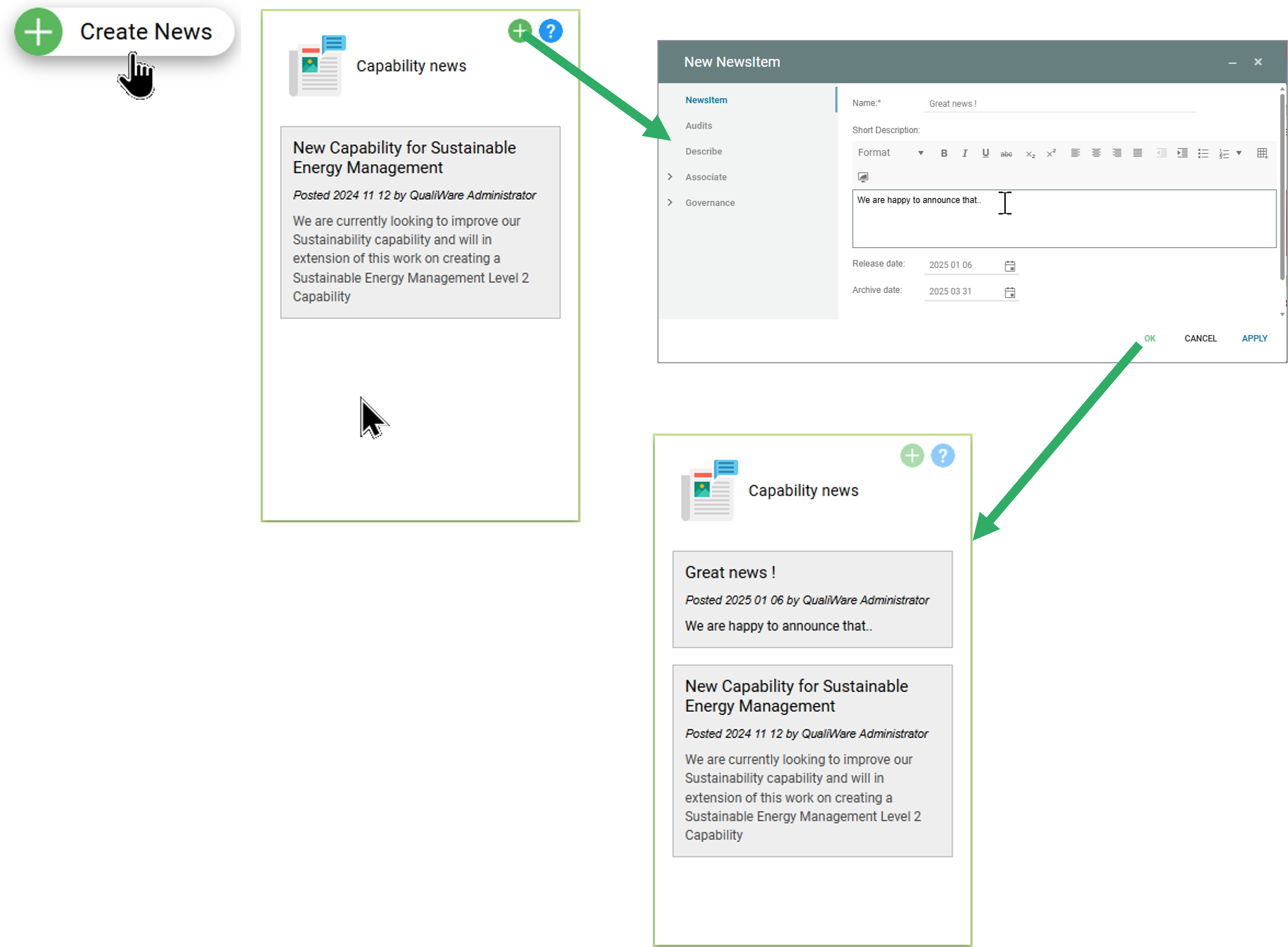
Select among available Desktops
As a user you will typically only use one or a few of the desktops, and it is possible to selects among available desktops and add or remove them as tabs to your workspace.

End-user Customizable
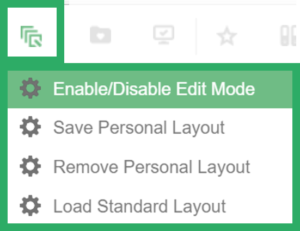
The Desktops are building on the Dashboard feature introduced in QualiWare 10.8. Hence, each desktop can be customized by the user.
All the tiles on the desktop can be re-sized and re-organized by drag and drop, and it is possible to hide tiles/items.
A user can save/remove the “Personal layout”, and at any time the standard layout can be reloaded.
Once a “Personal layout” is created it will be shown as default for the Desktop, and the user can “Load Standard Layout” if needed.
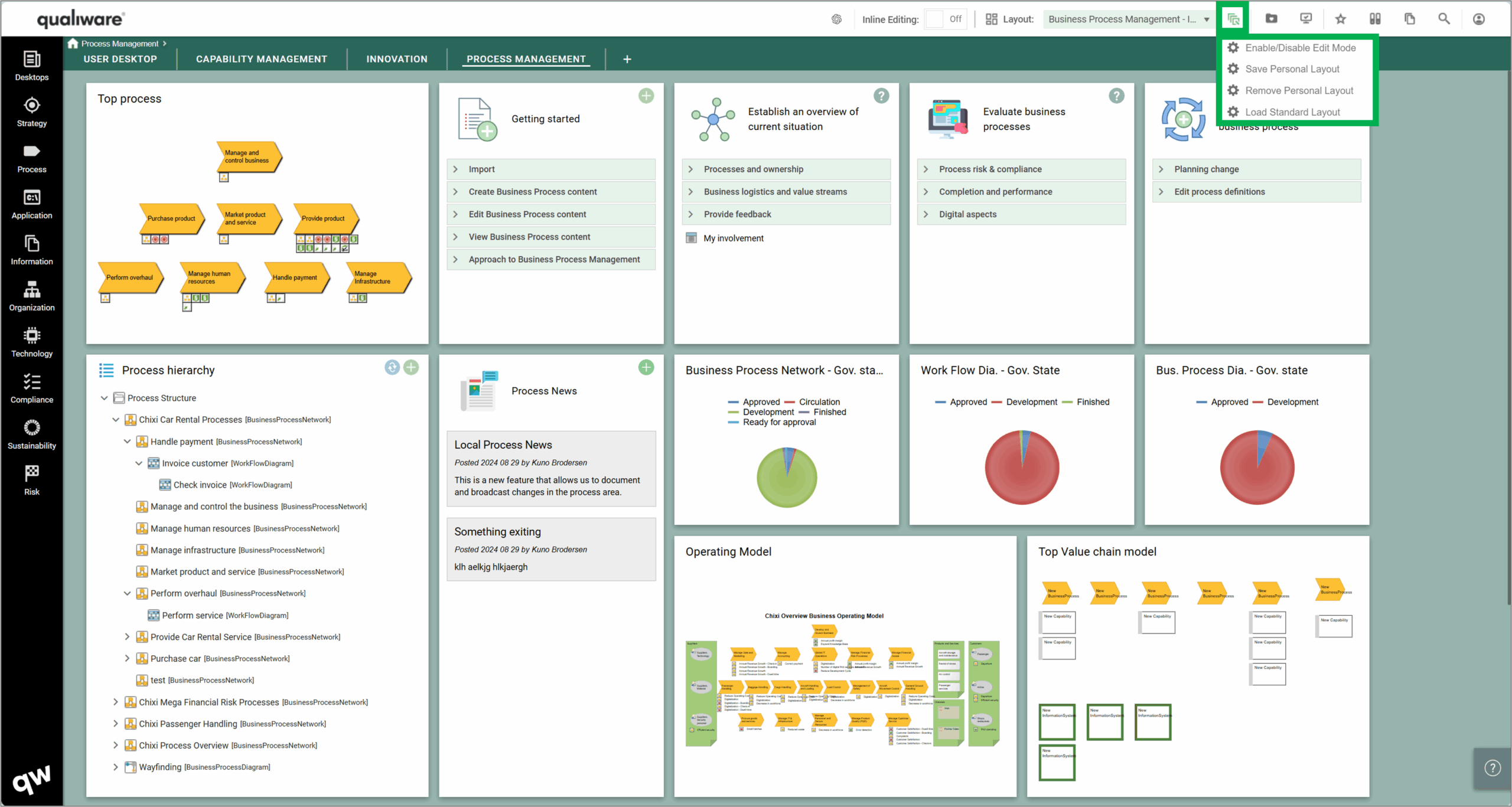
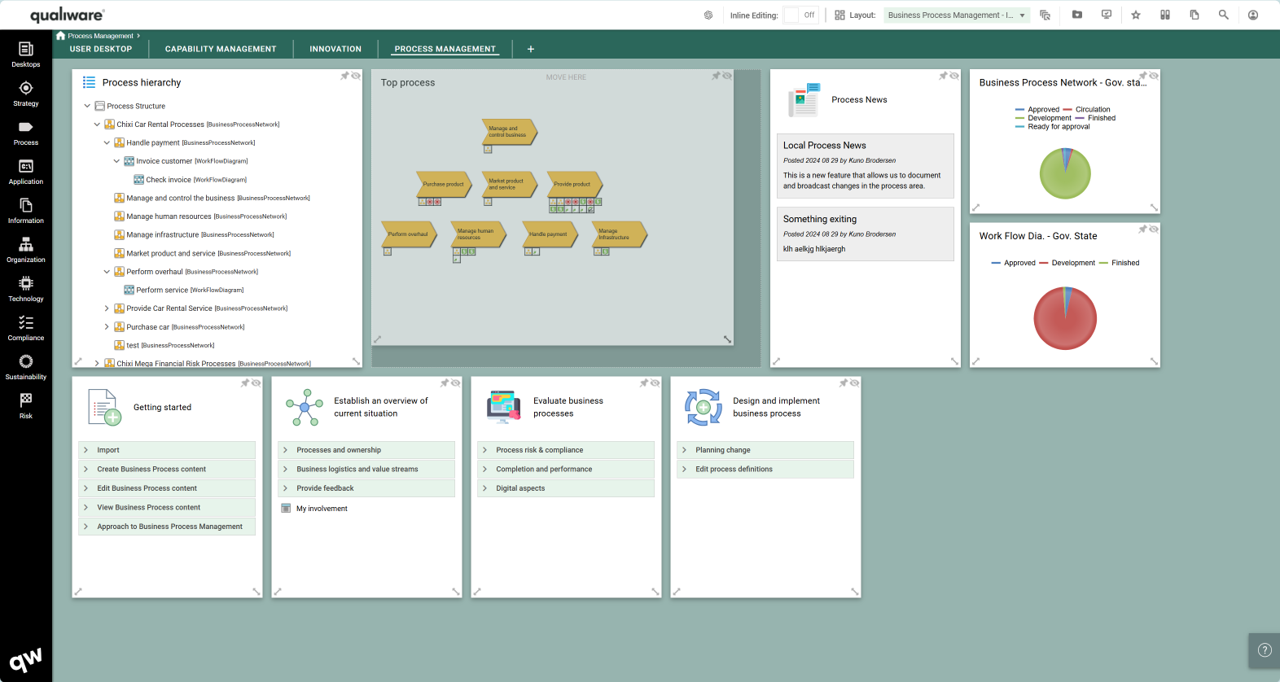
Personal Desktop
Every user has a Personal Desktop as a starting point.
A user can pin any diagram or content from other desktops to the personal desktop, hence creating a personal desktop with the relevant content fro the repository.
As with any other desktop, all tiles can be hided, re-sized and re-organized by drag and drop.
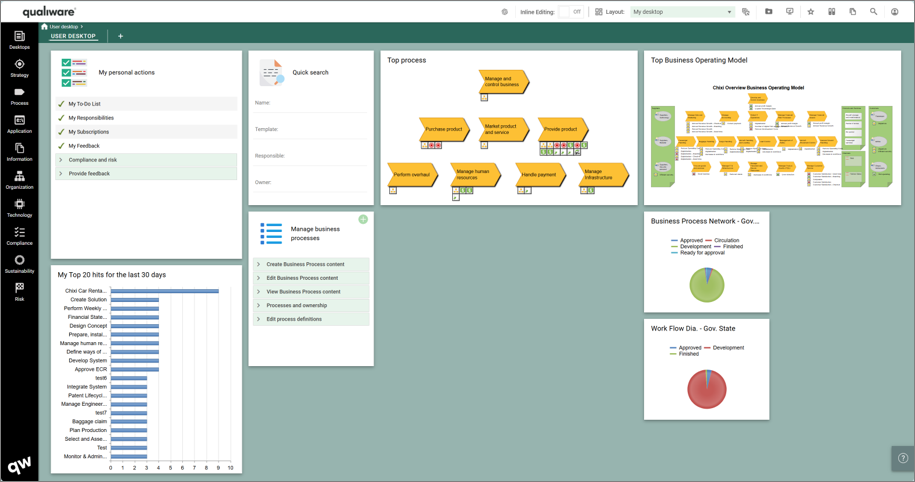
My Personal Actions
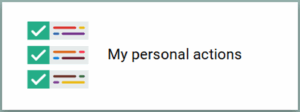
From the Personal Desktop the user has “My Personal Actions” which is a tile with easy access to lists and actions with user relevant and specific content.
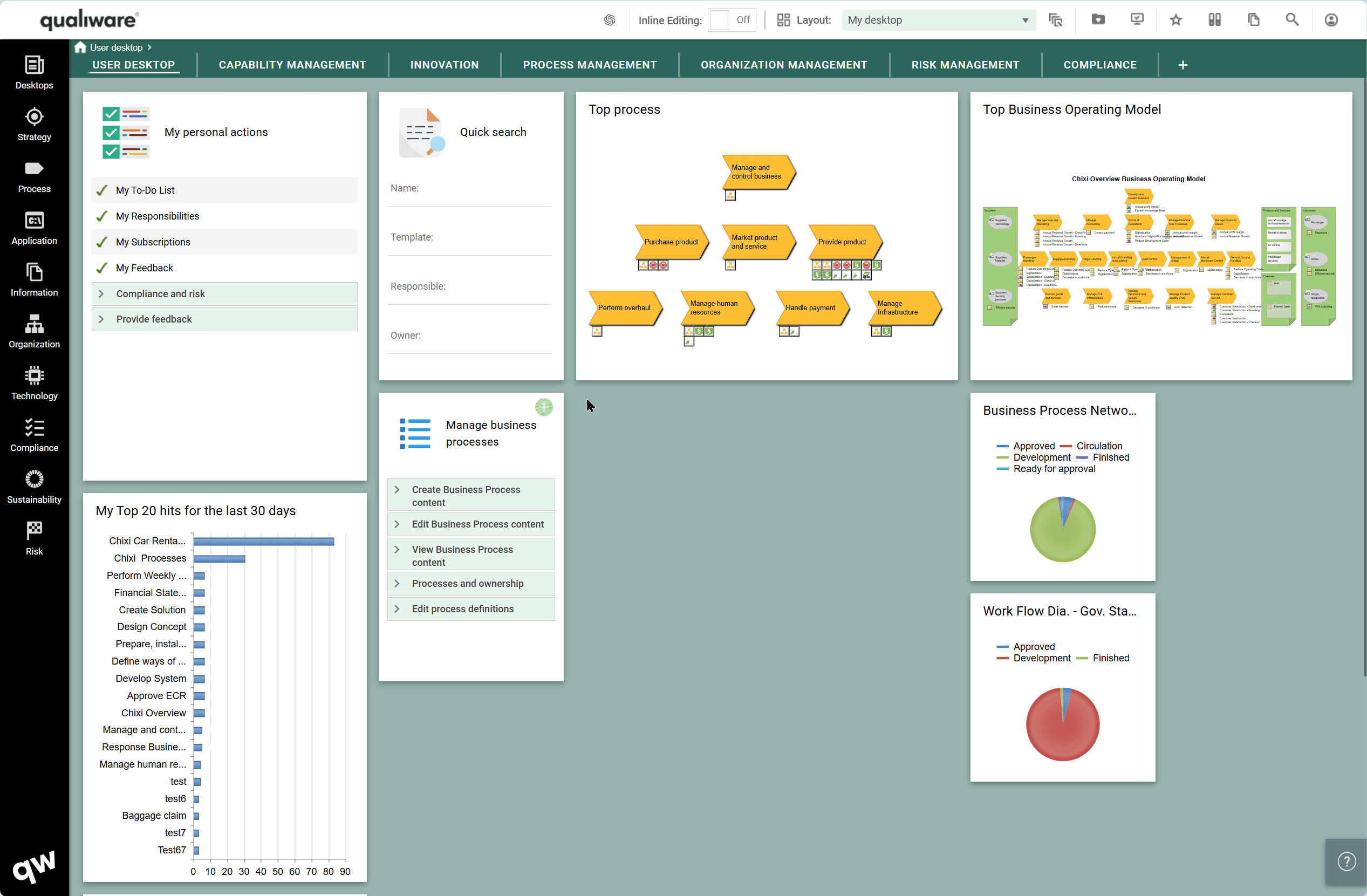
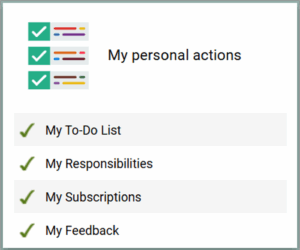
The first part of the Personal Actions lists:
- My To-Do list, lists all governance tasks assigned to the user (the corresponds to the “My Task” list known from the toolbar)
- My Responsibilities, lists all objects in the repository where the user is the responsible.
- My Subscriptions, lists all the users subscriptions, both personal and team subscriptions (the corresponds to the “My Subscription” list known from the toolbar)
- My Feedback, lists all ChangeRequest, Ideas and Problems, created by the user
The second part of the Personal Actions contains relevant lists related to Compliance and risk:
- My Audits (List of audits where the user is leadauditor)
- My Non-conformances (Non-conformances created by the user)
- My Corrective actions (Corrective actions created by the user)
- My Risks (Risk where the user is responsible)
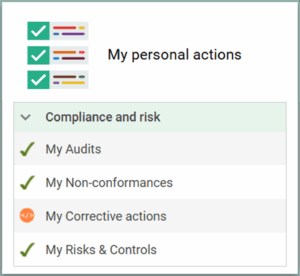
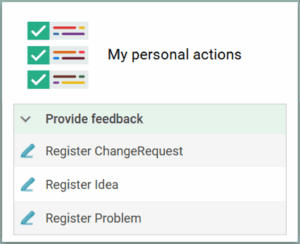
The last part of the Personal Actions gives the user easy access to create different types of feedback items:
- Register ChangeRequest
- Register Idea
- Register Problem
Pin to My Desktop

It is possible to pick and choose relevant parts from the different desktops and “pin” them to your user specific desktop, which will work as your default desktop.
In addition to pinning tiles from the different desktop it is also possible to “Pin” specific diagrams, using the icon in the toolbar.
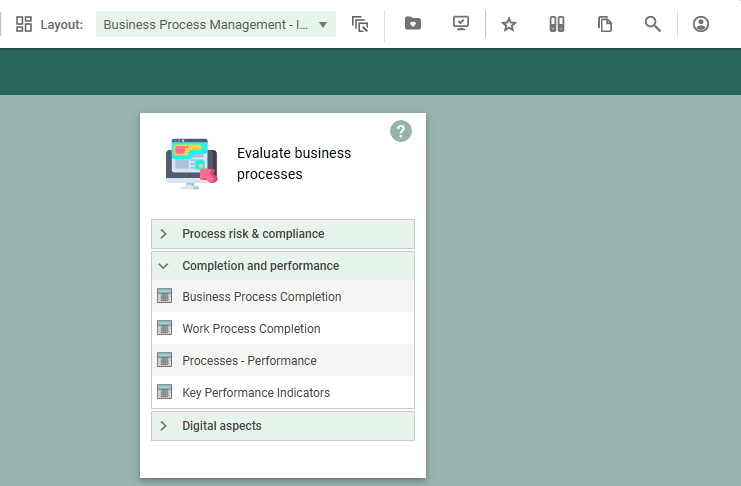
It is also possible to “Pin” specific diagrams, using the icon in the toolbar.

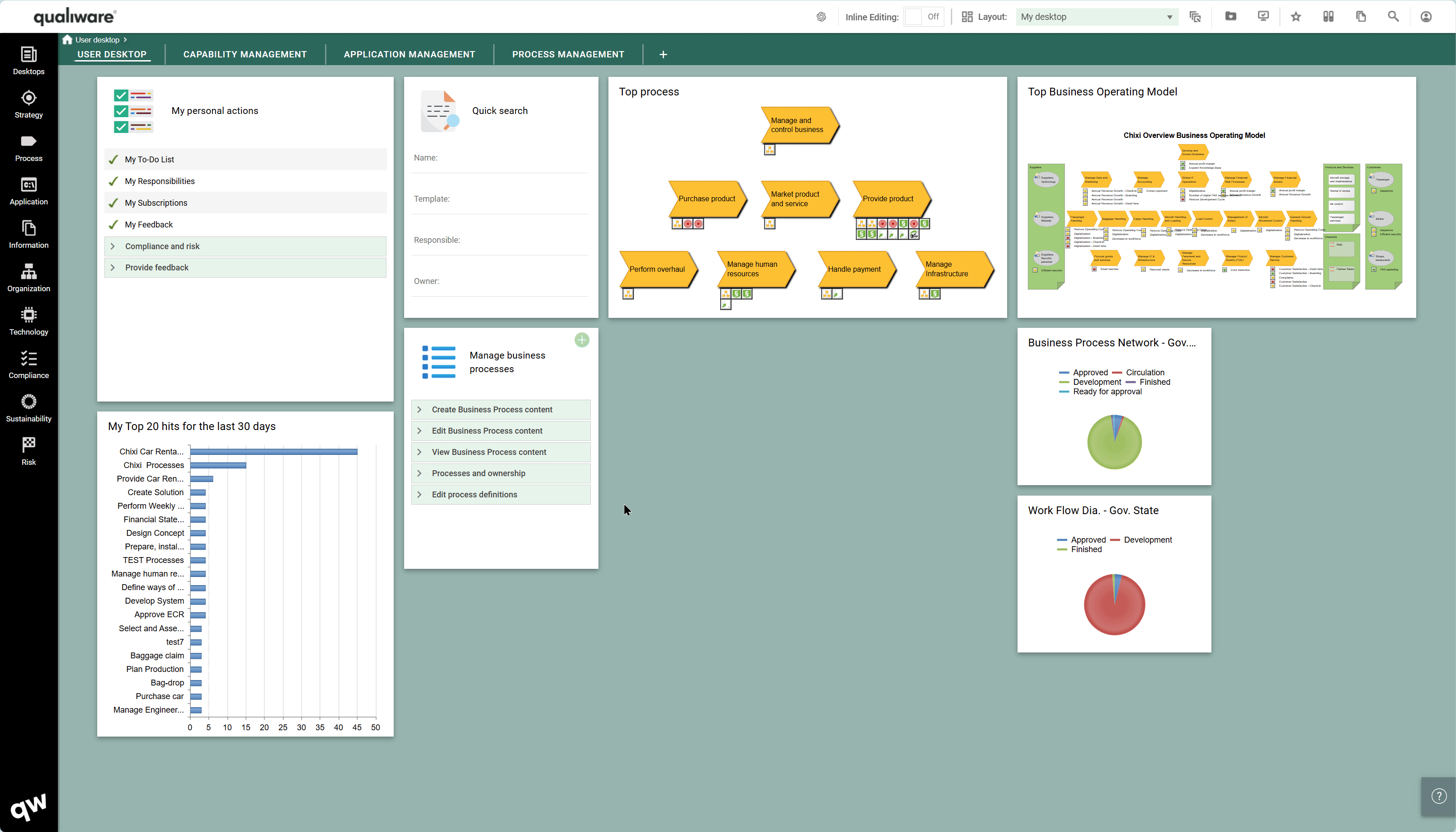
Additional features
Available help and guidance
The tile structure applied in the desktops aims to guide you through the most relevant steps within the desktop area.
As mentioned above, you can also find relevant links to content that contains a more methodological guidance or approach contained in the desktop.
One a more detailed level, you can also find (and update if relevant) help behind each tile. The help can be shown by clicking on the “?” in the upper right corner (when available).

Easy access to repository explorer
There is easy access to the repository explorer from the tiles.
The repository explorer view contains the relevant subset of templates associated to the scope of the desktop making it easy to explore the relevant content in the repository.
It is possible to have multiple lists, such as a list of diagrams and another with all templates related to the desktop domain.
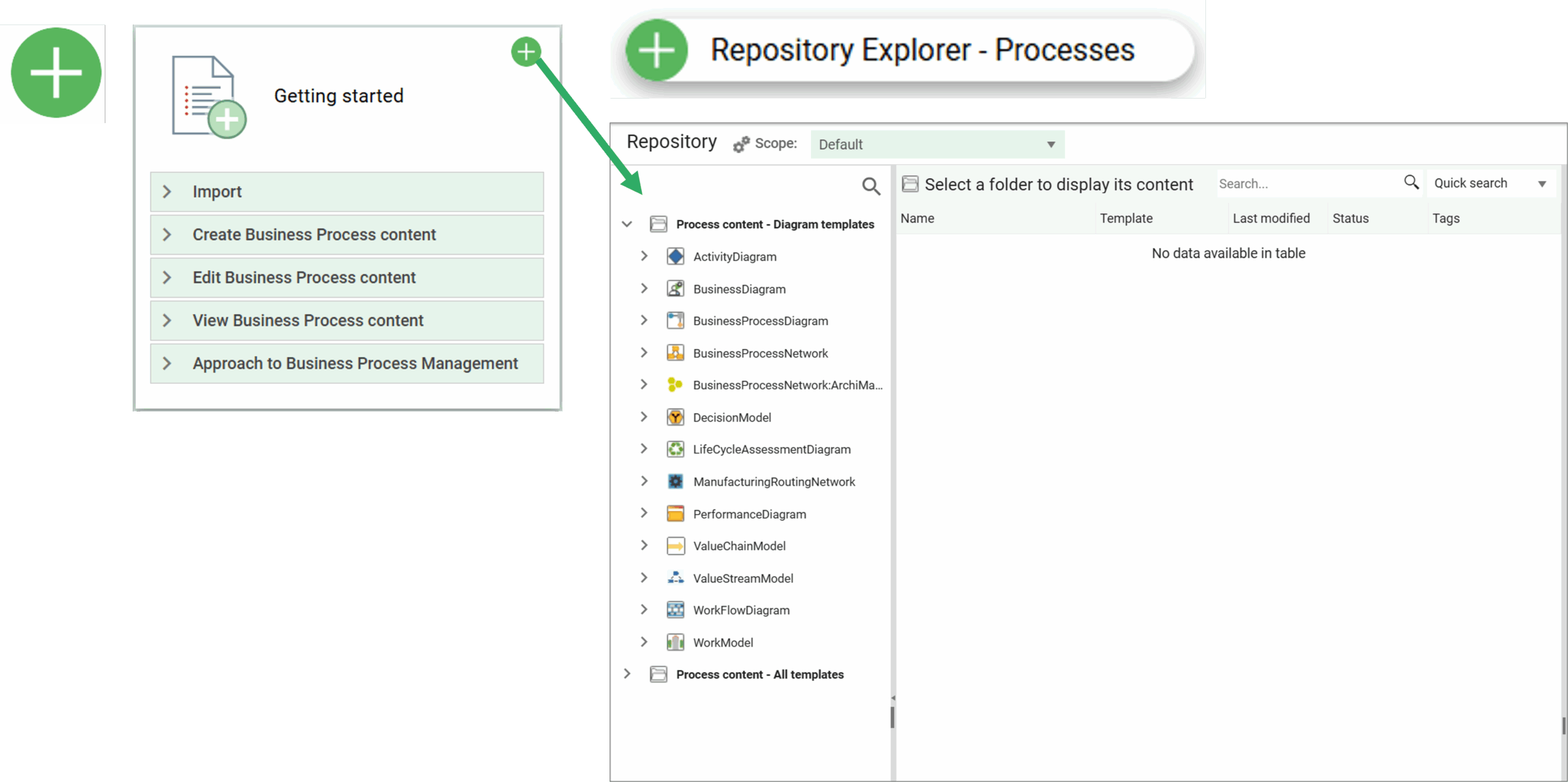
Read more about the Repository Explorer here.
Explore the standard Desktops
As standard QualiWare contains a new set of desktops, read more about the desktops below.
- All
- Architecture Framework Desktop
- Business Aspects Desktop
- Enterprise Design Desktop
- Governance-Risk-Compliance Desktop
Configuring Desktops
A set of standard Desktops are included in the standard publisher.
The desktops can be configured, enabling you to customize them to your need and update them if relevant.
Desktops uses HTMLDashboard
The Desktops are configured via the HTMLDesktop template applying one or more HTMLDashboards.
As usually the HTMLDesktops are associated to the web via the HTMLPublisher on the Personal Page Tab.
Note that to enable the new desktop functionality, introduced in QualiWare 10.10, the HTMLDesktop must only contain HTMLDashboard(s). If HTMLTiles are included in a HTMLDesktop, the behaviour of the desktop will change and the desktop will not be included in the list of available desktops.
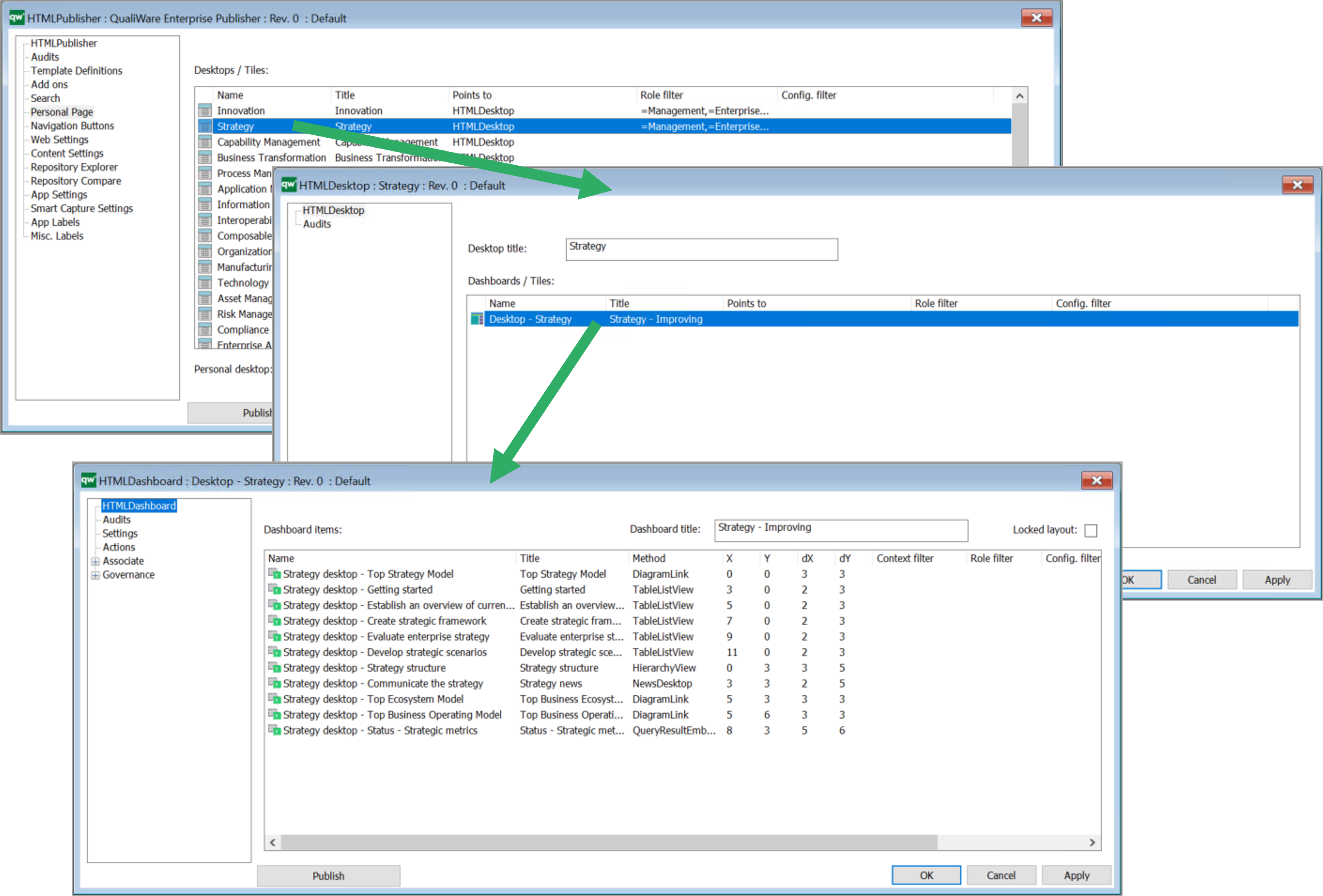
Similarly to the diagram dashboard, introduced in QualiWare 10.8, the Desktop are configured using the templates:
Note, to enable the new functionality the Desktops must be configured as HTMLDashboards and associated to the a HTLMDesktop in the HTMLPublisher.
